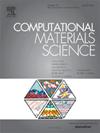二维材料层识别的轻量化模型和多智能体系统
IF 3.3
3区 材料科学
Q2 MATERIALS SCIENCE, MULTIDISCIPLINARY
引用次数: 0
摘要
二维(2D)材料的广泛采用和实施受到生长过程中精确控制原子层数量的挑战的阻碍。为了解决这个问题,我们提出了一个轻量级的模型,2D-TLK,用于分割和识别光学显微镜图像中原子层薄片的厚度和大小。该模型采用FastViT作为编码器,集成LRASPP和Knet作为解码器。2D-TLK模型在134张不同厚度的二硫化钼(MoS2)薄片图像上进行训练,准确率达到95.48%,平均mIoU为81.23%,推理速度更快,在图形处理器(GPU)上的推理速度为57.4帧/秒,在中央处理器(CPU)上的推理速度为1.80帧/秒。此外,对WS2和石墨烯图像的成功适应证实了其对不同二维材料的通用性。此外,我们还引入了一个多智能体系统,以提高交互性和分析效率。在该系统中,视觉代理与2D-TLK模型协同识别显微镜图像,编码代理配备代码解释器,处理识别结果。系统根据用户输入动态选择最合适的agent,智能分配任务,同时提供自然语言解释,实现高效直观的交互。该研究推进了模型驱动的材料表征,并通过将计算智能与实验材料科学联系起来,实现了人工智能辅助的科学发现。该代码可在https://github.com/zhouruiliangxian/2D-TLK上公开获得。本文章由计算机程序翻译,如有差异,请以英文原文为准。

A lightweight model and multi-agent system for layer identification in two-dimensional materials
The widespread adoption and implementation of two-dimensional (2D) materials are hindered by the challenge of precisely controlling the number of atomic layers during growth. To address this issue, we propose a lightweight model, 2D-TLK, designed for segmenting and identifying the thicknesses and sizes of atomic layer flakes in optical microscopy images. This model utilizes FastViT as the encoder and integrates LRASPP with Knet as the decoder. The 2D-TLK model was trained on a dataset 134 images of molybdenum disulfide (MoS) flakes with varying in thicknesses, achieve remarkable accuracy of 95.48%, a mean Intersection over Union (mIoU) of 81.23%, and faster inference times, with performance metrics recordingrapid inference speeds of 57.4 FPS (frames per second) on graphical processor unit (GPU) and 1.80 FPS on central processor unit (CPU). Additionally, successful adaptation to WS and graphene images confirms its generalizability to different 2D materials. Moreover, we introduce a multi-agent system to enhance interactivity and analytical efficiency. In this system, a Visual Agent collaborates with the 2D-TLK model to identify microscopy images, while a Coder Agent, equipped with a Code Interpreter, processes the recognition results. The system intelligently allocates tasks by dynamically selecting the most suitable agent based on user input, while offering natural language explanations for an efficient and intuitive interaction. This study advances model-driven material characterization and enables AI-assisted scientific discovery by linking computational intelligence with experimental materials science. The code is publicly available at https://github.com/zhouruiliangxian/2D-TLK.
求助全文
通过发布文献求助,成功后即可免费获取论文全文。
去求助
来源期刊

Computational Materials Science
工程技术-材料科学:综合
CiteScore
6.50
自引率
6.10%
发文量
665
审稿时长
26 days
期刊介绍:
The goal of Computational Materials Science is to report on results that provide new or unique insights into, or significantly expand our understanding of, the properties of materials or phenomena associated with their design, synthesis, processing, characterization, and utilization. To be relevant to the journal, the results should be applied or applicable to specific material systems that are discussed within the submission.
 求助内容:
求助内容: 应助结果提醒方式:
应助结果提醒方式:


